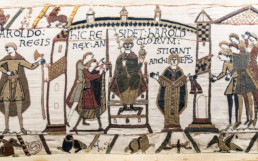HISTORY OF BOSHAM

The ancient village of Bosham (pronounced Bozzm) has a long and interesting history. There is evidence of occupation before the Romans came here; which included the finding of a Celtic stone head. Holy Trinity Church dates to Saxon times but was probably built on the ruins of a Roman basilica.
Legend tells that a fleet of pirates once sailed up Bosham Channel to plunder the village and church. They captured the tenor bell, but as they made off back down the channel, the bell fell through the bottom of the boat and sank into Bell Hole. On a still day, when the church bells ring, it is said that its muffled tones can be heard below the water, chiming in unison.
Some historians think King Canute lived here and that his daughter is buried in the church at the bottom of the Chancel steps. Canute is believed to have tried to turn back the tide here but he probably just built a dyke across the creek to re-claim the land. It wasn’t a great success!
In Saxon times, under the Charter of Bosham, a Man of Bosham (who had to be the son of a Man of Bosham), born here and who earned his living by the sea i.e. fisherman, boat builder and/or seaman, were given a number of rights, including free moorings throughout the realm, free pannage, tollage and murage and many other privileges. Bosham is thought by many to be the birth and burial place of the last Saxon King – Harold II (of 1066 fame). He is depicted in the Bayeux Tapestry praying in Bosham Church before sailing to Normandy to parley with William as to who should have the throne of England on the death of Edward the Confessor. In the Domesday Book of 1086, Bosham is recorded as being one of the wealthiest manors in England. It was long rumoured that there was an underground passage linking The Manor House to the church, amongst others, into which people have fallen from time to time.
Bosham was an important medieval port in Chichester Harbour, one of only three places in the harbour where wine could be landed. During the plague year of 1664, when a man was thought to have died of the disease in the Chichester, the citizens closed the city gates and asked for those outside to bring food to the people within. In gratitude the tradesmen of Bosham could sell their goods in Chichester without a hawker’s license.
Fishing, oyster fishing, brick making and boat building were all local industries. The Raptackle, a black wooden structure at the end of the quay was once used to sort oysters and to make ropes and repair nets. Unfortunately, limpets attacked the oysters and the trade was killed in 1922. However, the oysters are now returning to Chichester Harbour.
Bosham Sailing Club (whose badge is a red bell on a white background), is in the old water mill on Bosham Quay. Quay Meadow, a grassy area between the church and the quay, is owned by the National Trust and is a marvellous place to sit and watch the activity on and around the water.
In the High Street you can discover the Anchor Bleu, an inn since 1741. It is an ideal location from which to observe the Bosham sea car wash! Sea water covers the roads around the shore twice a day and the vehicles of hapless drivers, who foolishly ignore the warning signs and leave their cars parked there within 2 hours of high tide! Nearby is Bosham Walk, once a garage and which is now the arts and crafts centre.
